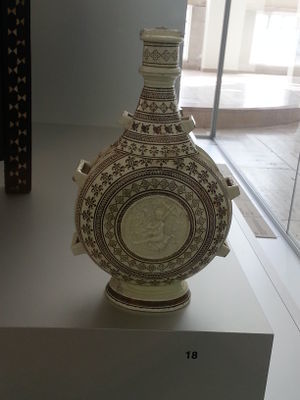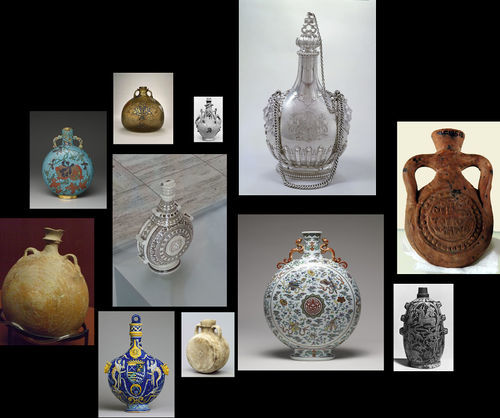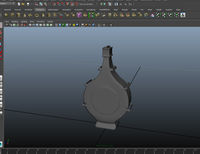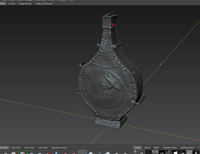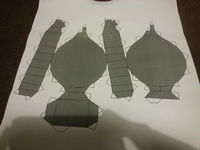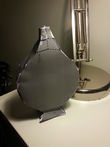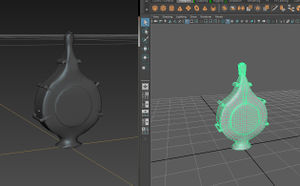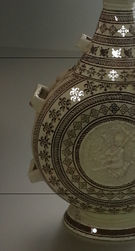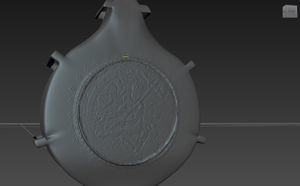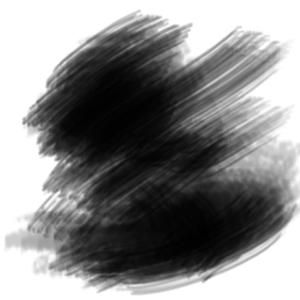Difference between revisions of "User:JMvdKOLK/MuseumOfFantasticForgeries"
| (4 intermediate revisions by the same user not shown) | |||
| Line 31: | Line 31: | ||
I went back to my 3D model and imported into Mudbox, The current model was rather square. I made it rounder and reimported to Maya where I fixed the quads. After I reimported it back to mudbox I had to try and replicate the symbols on it. I opened a photograph I made in illustrator and traced the symbols. After that I exported each symbol individually and imported them as stamps in Mudbox. I started experimenting with them on the model to get the same kind of texture and paths as the real one. | I went back to my 3D model and imported into Mudbox, The current model was rather square. I made it rounder and reimported to Maya where I fixed the quads. After I reimported it back to mudbox I had to try and replicate the symbols on it. I opened a photograph I made in illustrator and traced the symbols. After that I exported each symbol individually and imported them as stamps in Mudbox. I started experimenting with them on the model to get the same kind of texture and paths as the real one. | ||
| − | [[File:JVDKBeforeandafter.jpg | Thumb | | + | [[File:JVDKBeforeandafter.jpg | Thumb | 300px]] |
[[File:JVDKilluSymbols.jpg |Thumb | 135px]] | [[File:JVDKilluSymbols.jpg |Thumb | 135px]] | ||
| − | [[File:JVDKallsymbols.png | Thumb | | + | [[File:JVDKallsymbols.png | Thumb |300px]] |
| − | [[File:JVDKTexturedPatterns.jpg | Thumb | | + | [[File:JVDKTexturedPatterns.jpg | Thumb | 300px]] |
| + | |||
| + | I further optimized the object and started adding each symbol on the model. I noticed I needed to change the symbols due the shape was being faded out at the edges. I looked at the reference photos I made and added each symbol based on that. My first idea of transformation was that people could interact with the object. I'm currently busy with turning the High Poly object into a Low poly object. Makes it easier to work with it. | ||
| + | |||
| + | If they touched it, there would be a dirt/smear patch or changes the shape of the object. I started coding and making a prototype in Unreal, where I loaded the objects in placed them on a stand. Whenever I touched the mouse button a small dirt patch was added to the scene. I tried creating a rotating object, but the dirt patches didn't want to stick to the object. | ||
| + | |||
| + | Here you can download my Unreal engine test. | ||
| + | [https://dl.dropboxusercontent.com/u/49774103/UnrealExample.zip Unreal Example test] | ||
| + | |||
| + | |||
| + | After a feedback session with Roel, It would be nice to create a mini museum where you can walk around and see the different steps I took to reproduce this object in 3D. It would show several stands that explain my steps and go further into detail. My transformation of the object would be by taking the object and make it usuable again for the public. Either by modding it into games. Think of games like skyrim, where you can find the bottle and use it. I could publish the object online and let other people use it. | ||
| + | |||
| + | [[File:JvdkFlash mudbox allsymbols.jpg | Thumb | 300px]] | ||
| + | [[File:JVDKTest.png | Thumb | 300px]] | ||
| + | [[File:JVDKConceptReproduction.jpg | Thumb | 300px]] | ||
</center> | </center> | ||
Latest revision as of 21:26, 16 October 2015
Personal Notes: HERE
The Object
The Object I chose was from the Boijmans Museum and exhibited in the Design collection. The object was one of the items I chose for the kick off week. I chose it based on shape and form, so I did not find out what it actually was. When I had to choose an object for this assignment, I was still intrigued by this item and wanted to know more of it.
The Beginning
The first thing I did, was figuring out what it actually was. On the Boijmans website I managed to track it down in their online catalogue. It gave me its history, material and what it was. There was not a lot of information given about the certain object except that it is a pilgrim's bottle. So what's a pilgrim bottle? A pilgrim bottle was an object carried by travelers on their journey. While most that survived were very expensive that it is assumed that they must be purely for display; however they were made everywhere from Asia to Europe and various materials. They all retain the same characteristics though. it's a vessel with a body from an almost full circle, flattened, to a pear shape with a shortish neck, a spreading foot and, generally, two loops on the shoulders. Through the loops either a chain or a cord was passed from carrying the bottle or for maintaining the stopper in place. Additionally, They have religious imagery.
Our bottle has not much information, but enough to possible deduce what the user was worshipping. it's made using relief-application. A method of adding pieces of clay to the layer which creates relief. It's origin is in France, Saint Porchaire from 1525-1565. There is a church in Pontiers named the St. Porchaire. It was finished in the 16th century, It's a sacred place for pilgrims to visit. This is because the sacrophage of ST. porchaine. The church's origin is from Carolingian dynasty, romanisque and gothic. It also has The Twelve Apostles imagery which make me believe it's faith is based on Christianity. The imagery on the pilgrim's bottle is also depicted a person with a religious cross.
It poses a question of what journeys it has made, what it was depicting and how it ended up here in holland? For me the most fascinating part of the object is its journey.
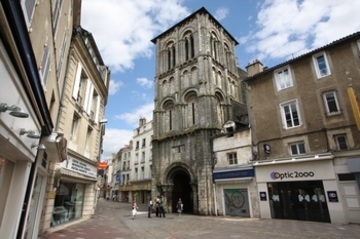
The Reproduction Journey
My current idea was to recreate this object in 3D, its idea of relief-application made me think about sculpting this in a 3D environment and find a way to make it real. This could be 3D printing or another way. I've started with trying to sculpt it in Mudbox only, this turned out to be very poor and time consuming. Mostly because of my inexperience in Mudbox itself. I decided to create the basic form and shape in Maya, which resulted in having to optimize it a lot with using quads and mirroring the shapes. eventually I imported the flask to mudbox where I started to work with its textures and detail. As an experiment I've recorded part of the proces.
Because of the feedback session, I realized that what I found the most fascinating part of my reproduction was actually the digital sculpting of the actual art object. I wanted to visualize this somehow. While I was fixing the 3D object in maya for a more smooth export road to Mudbox, I was interested in the quads I was working with. I wanted to see if I could bring this into the real world somehow. I came across paper craft, which is paper folded into three dimensional shapes and forms. I searched how I could transform my object into a papercraftable template. I found a program called Pepakura Designer which unfolds the object for you into a printable form. I took the design with me and printed it on A3 and started cutting the shape out of the paper, folded the paper and glued the piece together. This turned the 3D object into a real object, because of its blocky and flat texture it gave it this 3D quads feeling.
I went back to my 3D model and imported into Mudbox, The current model was rather square. I made it rounder and reimported to Maya where I fixed the quads. After I reimported it back to mudbox I had to try and replicate the symbols on it. I opened a photograph I made in illustrator and traced the symbols. After that I exported each symbol individually and imported them as stamps in Mudbox. I started experimenting with them on the model to get the same kind of texture and paths as the real one.
I further optimized the object and started adding each symbol on the model. I noticed I needed to change the symbols due the shape was being faded out at the edges. I looked at the reference photos I made and added each symbol based on that. My first idea of transformation was that people could interact with the object. I'm currently busy with turning the High Poly object into a Low poly object. Makes it easier to work with it.
If they touched it, there would be a dirt/smear patch or changes the shape of the object. I started coding and making a prototype in Unreal, where I loaded the objects in placed them on a stand. Whenever I touched the mouse button a small dirt patch was added to the scene. I tried creating a rotating object, but the dirt patches didn't want to stick to the object.
Here you can download my Unreal engine test. Unreal Example test
After a feedback session with Roel, It would be nice to create a mini museum where you can walk around and see the different steps I took to reproduce this object in 3D. It would show several stands that explain my steps and go further into detail. My transformation of the object would be by taking the object and make it usuable again for the public. Either by modding it into games. Think of games like skyrim, where you can find the bottle and use it. I could publish the object online and let other people use it.
